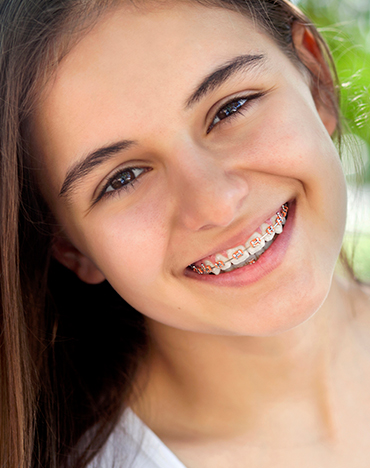Braces
Traditional braces have come a long way since they were invented in the early 1800’s. Today, traditional braces are by far the best teeth-straightening options, for the most natural, organic long lasting smile. There are (2) types of traditional braces which are Metal Braces and Clear Braces.
Metal Braces – Traditional metal braces are used in children, teenagers and adults. Metal braces are the most affordable treatment and use a system of brackets and wires to move the teeth over time.
Clear Braces – These innovative clear braces work exactly like traditional metal braces, except that the brackets bonded to the teeth are made of ceramic. This helps prevent staining, and they can also be color-matched to blend with the teeth. We straighten patients teeth with the same technique and results as traditional metal braces, but with less noticeability.
Do I need braces?
The only way to determine whether traditional braces are a right fit for you is to schedule an appointment for a free consultation. You do not have to have crooked teeth to benefit from braces. Even patients with a little bit of crowding can benefit from orthodontic treatment. When the teeth are properly aligned you can better clean between them, preventing decay and gum disease. Furthermore, teeth that are aligned properly can help patients with malocclusion complications, such as headaches.
What should I expect while I have braces?
You will have certain dietary restrictions with most types of braces except Invisalign. Hard, sticky and chewy foods (like candy), can have a negative effect on braces and damage the brackets and/or wires. Monthly office visits are needed to have wires tightened and for general progress of your treatment. If you have Invisalign, generally there are no food restrictions, as the trays can be removed when eating. You’ll also be able to switch to a new Invisalign tray every few weeks without visiting the office.
What happens when my orthodontic treatment is complete?
Once orthodontic treatment has been completed, the use of retainers after braces is a very important part of the continuing maintenance of teeth and will go a long way toward keeping the same bite and smile that the braces formed over the previous few years. There are two types of retainers after braces: Fixed and removable. The fixed type of retainer is usually a thin wire worn across the back of the lower or upper front teeth, which is bonded in place with a cement similar to that applied on the brackets of braces. Removable retainers must be worn at night time, while you sleep.
Do I need braces?
The only way to determine whether traditional braces are a right fit for you is to schedule an appointment for a free consultation. You do not have to have crooked teeth to benefit from braces. Even patients with a little bit of crowding can benefit from orthodontic treatment. When the teeth are properly aligned you can better clean between them, preventing decay and gum disease. Furthermore, teeth that are aligned properly can help patients with malocclusion complications, such as headaches.
What should I expect while I have braces?
You will have certain dietary restrictions with most types of braces except Invisalign. Hard, sticky and chewy foods (like candy), can have a negative effect on braces and damage the brackets and/or wires. Monthly office visits are needed to have wires tightened and for general progress of your treatment. If you have Invisalign, generally there are no food restrictions, as the trays can be removed when eating. You’ll also be able to switch to a new Invisalign tray every few weeks without visiting the office.
What happens when my orthodontic treatment is complete?
Once orthodontic treatment has been completed, the use of retainers after braces is a very important part of the continuing maintenance of teeth and will go a long way toward keeping the same bite and smile that the braces formed over the previous few years. There are two types of retainers after braces: Fixed and removable. The fixed type of retainer is usually a thin wire worn across the back of the lower or upper front teeth, which is bonded in place with a cement similar to that applied on the brackets of braces. Removable retainers must be worn at night time, while you sleep.

